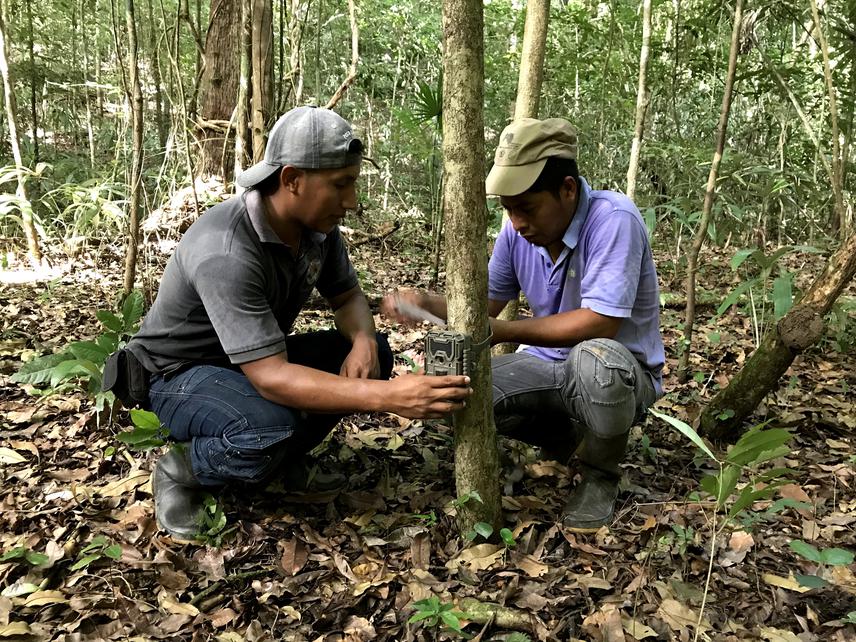Social media video featuring the project.
Below - Jaguar (Panthera onca) marking its territory in Chankin Natural Protected Area. © Mayan Jaguars Program & Voluntary Surveillance Committee of Chankin Flora and Fauna Protected Area
23 May 2018 Frontera Corozal, Mexico, Central and Latin America Carnivores | Communities | Habitats | Mammals
Research for the Conservation of the Jaguar in the Selva Lacandona, Chiapas, Mexico
One of the most important jaguar populations in Mexico occurs in the landscape known as Greater Lacandona Ecosystem (GLE). This proposal seeks to contribute in the long term persistence of this population implementing a participatory monitoring program addressed to jaguars and their prey in the protected areas of the northern GLE, enforcing the surveillance activities within the natural reserves through the training of two groups of local people in the SMART platform, and implementing an educational and communication strategy with the aim of inform to local communities about the ecological and conservation importance of the jaguar and other emblematic species. With this we expect to have robust elements to contribute in the consolidation of a jaguar conservation strategy addressed to the Cho´ol indigenous community located in Frontera Corozal, which are land owners of an important section of the Greater Lacandona Ecosystem.

Victor and Rigober to, who are community monitors, deploying a camera trap in Yaxchilán Natural Protected Area. ©Paulina Arroyo.
One of the most important and studied jaguar populations in Mexico occurs in the Southern Mayan Forest, in the landscape known as Greater Lacandona Ecosystem (GLE). In 2011 (with the support of RSG), we estimated that protected areas of this region could contain an important population of jaguars, potentially the second largest one in Mexico. Since 2014, we have focused our work to study and protect jaguars in the GLE, through the engaging of local people in the monitoring program of jaguars and implementing other conservation activities to diminish the threats for the species in the region. The goal of this initiative is to implement a long term monitoring program focused on jaguars and their prey involving actively the local communities. However, it’s necessary to strengthen these activities for the northern region of the GLE.
Through this current project we will consolidate two groups of local monitors who will implement surveillance and monitoring activities in Chan-kin and Yaxchilán Natural Protected Areas and within the communal reserve known as Sierra de la Cojolita which are located in the northern section of the GLE. Monitoring of jaguar and other emblematic species will be carried on by these two groups of local monitors using camera traps. Local monitors also will be trained in the SMART platform usage to improve surveillance activities in the crucial areas for jaguar conservation in the northern GLE. Additionally, we will develop an educational and communication strategy to inform the local communities about the ecological and economic importance of the jaguar for changing the negative perceptions of local people about the species. We expect that this project raise awareness in the local community about the value of the GLE region for conserve the overall biodiversity in southern Mexico and to ensure the long term viability of emblematic species such as the jaguar, Baird’s tapir and white-lipped peccary.
Additionally, we expect that information obtained through this project gives robust elements to the National Commission of Protected Areas (CONANP-Mexico) for implement adequate management actions for ensuring the long-term conservation of the Natural Protected Areas of the region.
Social media video featuring the project.
Below - Jaguar (Panthera onca) marking its territory in Chankin Natural Protected Area. © Mayan Jaguars Program & Voluntary Surveillance Committee of Chankin Flora and Fauna Protected Area
Social media videos featuring the project.
Jaguar (Panthera onca) marking its territory in Chankin Natural Protected Area (© Mayan Jaguars Program & Voluntary Surveillance Committee of Chankin Flora and Fauna Protected Area),